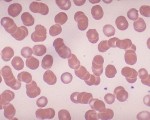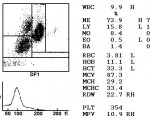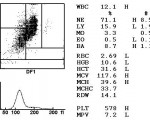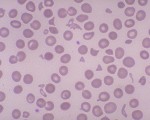
knizocytes a specific shapes of erythrocytes
The term knizocyte describes a specific shape form of erythrocytes that deviates from the standard form. These cells have two concavities instead of the one seen with normal erythrocytes. ...

rouleaux formation
The RBC’s here have stacked together in long chains. This is known as “rouleaux formation” and it happens with increased serum proteins, particularly fibrinogen and ...

hypochromic microcytic anemia
Note the larger zones of central pallor in these small RBCs, along with poikilocytosis. The most common cause for a hypochromic microcytic anemia is iron deficiency. The most common ...

CBC of microangiopathic hemolytic anemia
The CBC of a patient with microangiopathic hemolytic anemia (MAHA) demonstrates a markedly increased RDW (red cell distribution width) due to the marked variation in size and shape ...

H-hemoglobin disease
H-hemoglobin disease
————————––
An inclusion body positive cell seen in Brilliant Cresyl Blue stained red cells of a α0-thalassaemia ...

Fungemia
Fungemia is the presence of fungi or yeasts in the blood. The most common type, known as Candidemia which caused by Candida species.
It is most commonly seen in immunosuppressed or ...

Microcytosis
The term ‘microcytosis’ means small red cells. The three main causes are iron deficiency, some cases of the anemia of chronic disease, and the thalassemia syndromes. Sideroblastic ...

CBC with megaloblastic anemia
CBC with megaloblastic anemia
====================
The CBC here shows a markedly increased MCV, typical for megaloblastic anemia.
The MCV can be mildly increased in persons recovering ...

fragmented RBCs (schistocytes)
There are numerous fragmented RBC’s seen here. Some of the irregular shapes appear as “helmet” cells. Such fragmented RBC’s are known as “schistocytes” ...

How Thalassemia is passed on from parents to children
How Thalassemia is passed on from parents to children


